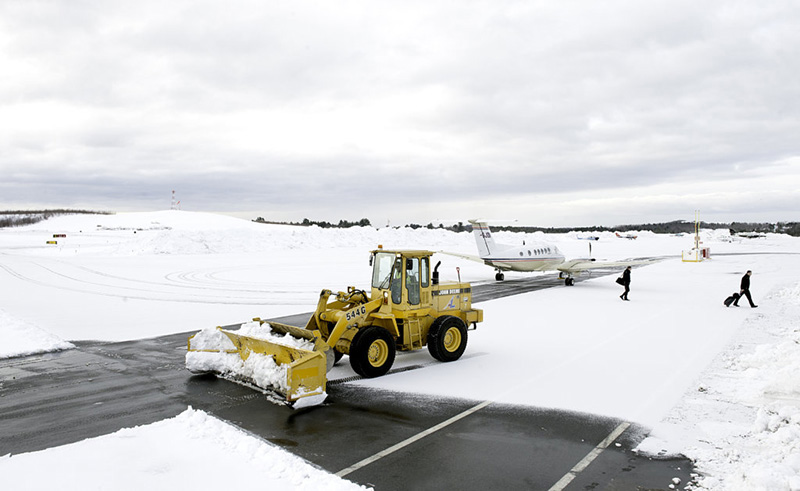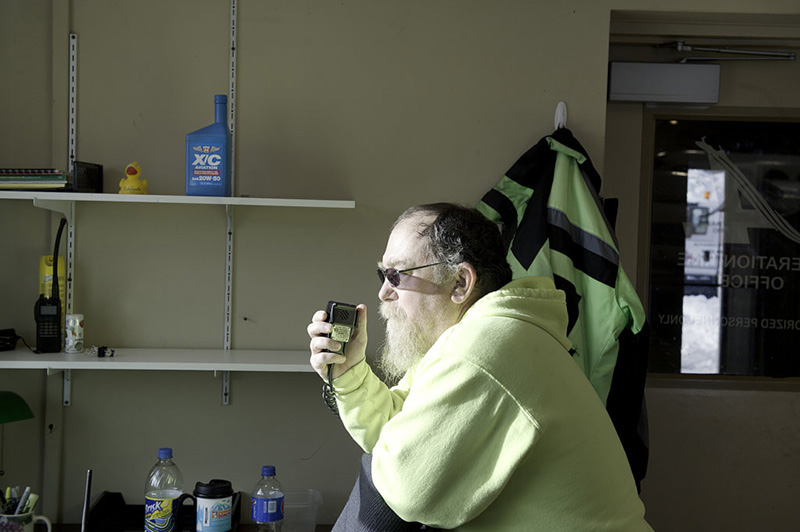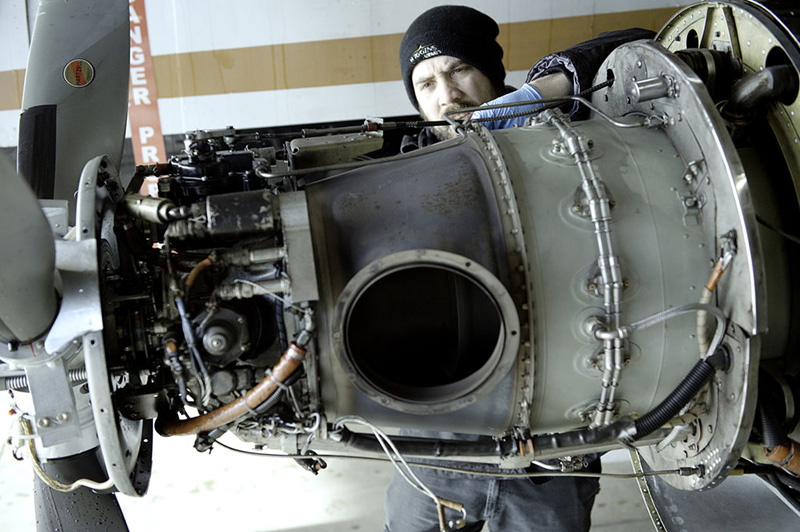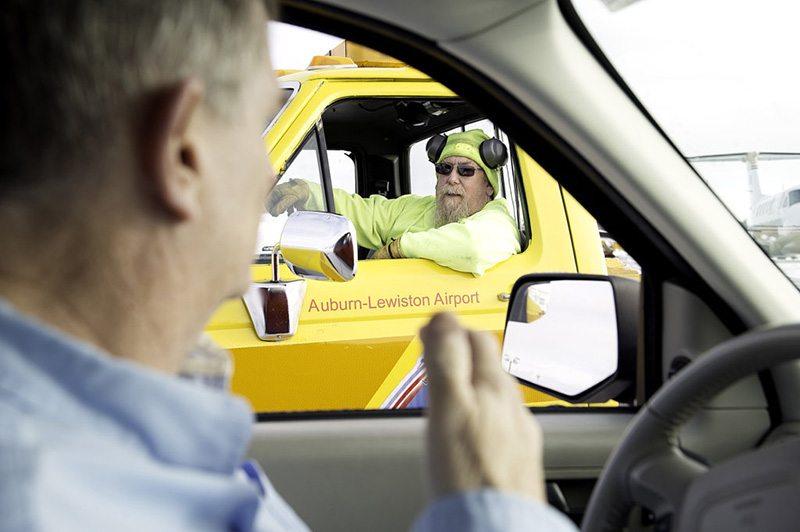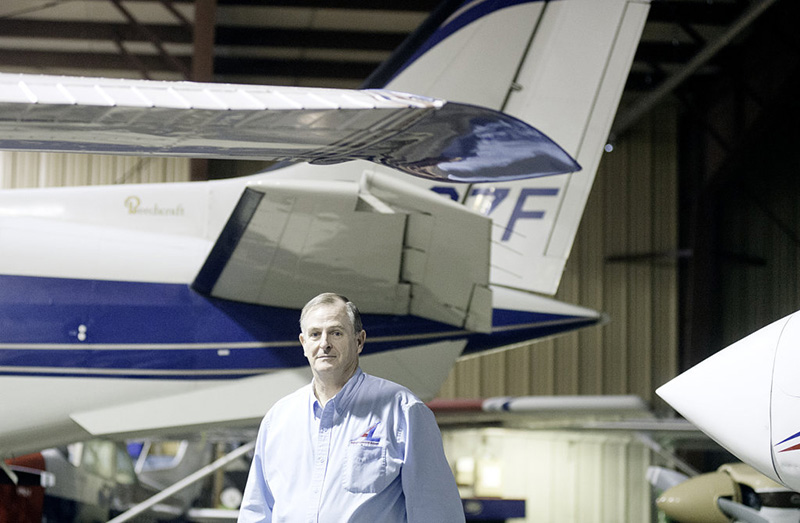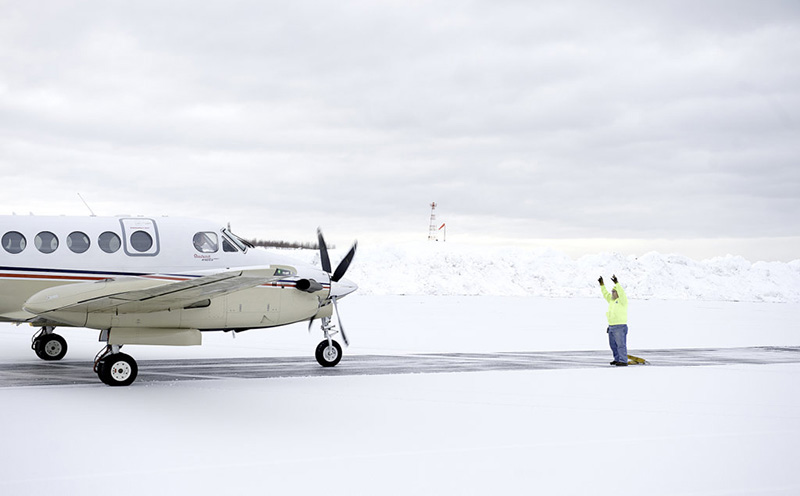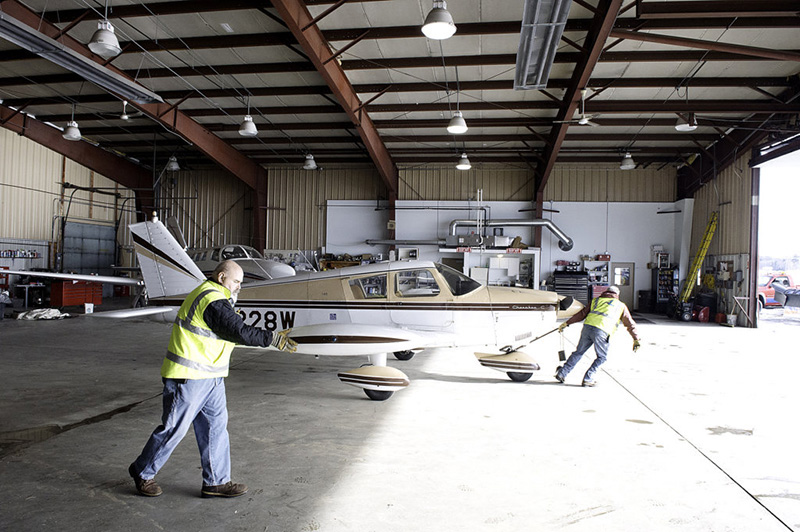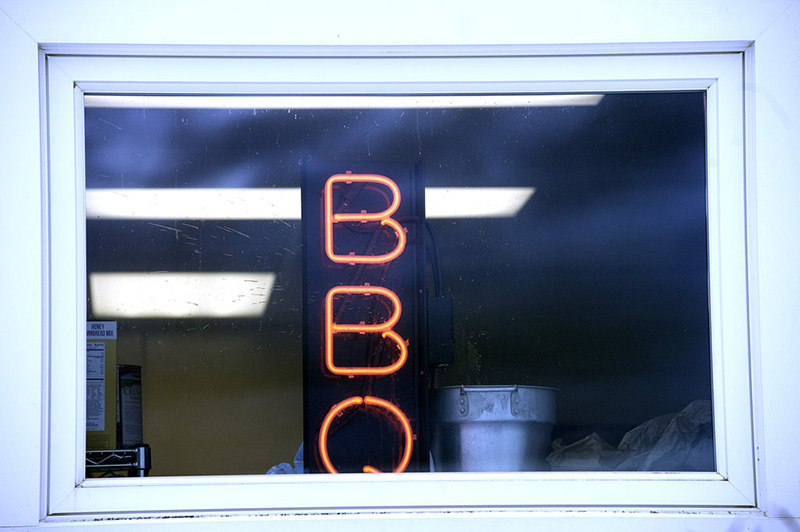AUBURN — During a snowstorm a month ago, a pair foxes were playing on an airport runway, oblivious to the twin-engine bearing down overhead.
The pilot had to decide at the last second: land smack on a fox or ditch the plane?
Suddenly, the closest animal looked up, bolted, and the Auburn-Lewiston Municipal Airport maintained its zero-fox-strike record.
As airport Director Rick Lanman tells it, it’s a quaint if harrowing tale, as is the effort that goes into keeping the airport deer-free: When deer easily scale the barbed-wire-topped fence, staff have to fan out in cars to drive them off.
Crews earlier this month thinned woods around the 624-acre property, partly to make it less enticing to wildlife. It’s the kind of thing that might be expected of a sleepy rural airstrip, but the runways at Auburn-Lewiston Municipal Airport don’t sleep all that much.
Last year, an estimated 52,560 planes took off or landed there.
By that measure, it was the second-busiest airport in Maine – ahead of Portland, Bangor and everyone but Sanford, according to the Federal Aviation Administration, a double-take-inducing distinction.
“I expect the skepticism,” Lanman said.
He wasn’t even aware of how it rated until an FAA official mentioned that in 2016, it had been No. 1.
BEHIND THE NUMBERS
Some of that 52,560 is UPS, which has a delivery center in Auburn. A big chunk is privately owned small aircraft. Some are campers headed to Maine’s famous lakes. About one-third are corporate travelers Lanman said.
Picture instead eight middle-managers filing out of an eight-seater plane.
“They’ll be glad they’re on the ground; a lot of them are not as comfortable as you think,” he said. Once inside the Auburn terminal, “a lot of them go straight to the bathroom.”
Over the next three years, Lanman hopes to enhance the airport through $8.7 million in improvements that include tripling the size of the paved parking lot, resurfacing one runway and repaving another.
The idea is to spruce up parts that need improving – for example, “our current runway is 27 years old, but it’s only supposed to be 20,” he said – and offer a modern, welcoming face that leaves a good impression and keeps planes coming back.
“There’s no sense sitting still,” Lanman said. “The job of the airport is to support the community. If nothing else, we need to earn our keep.”
FIVE BUSIEST DAYS
The Twin Cities have operated the airport since the U.S. Navy turned it over in 1945. (It had been used as a base where, among others, future President George H.W. Bush trained.) The cities created a quasi-municipal government corporation to formally oversee it in 1979.
Its budget last year was $1.5 million, including $167,800 each from Lewiston and Auburn for operations and another $43,000 for capital improvements.
This year’s ask is $172,000 each for operations plus an additional amount for capital costs. The rest of the airport’s budget is made up from revenue, including annual sales of 130,000-plus gallons of aviation fuels, plane storage fees and a cut of fees on the more than 5,000 cars rented out at the airport each year by Hertz and Enterprise.
Lanman came here in 2012 from an Arkansas airport. He oversees a staff of 10 to 12 people.
His first large A-L project: a $900,000 expansion of the “terminal apron,” adding almost 3,000 square yards of new plane parking two years ago.
“It actually gave us enough parking space that last year during campers’ weekend, we didn’t have to close the runway and we still had 40 airplanes parked out here,” Lanman said.
Campers’ weekend is an equally quaint misnomer; it’s actually the five busiest days of the year for the airport, a Thursday-to-Monday span responsible for nearly half of the airport’s passenger traffic for the entire year.
The draw: Maine’s storied, and sometimes luxe, summer camps. When Town & Country Magazine compiled a list of 19 spots representing “the Ivy League of summer camps” last July, seven were in Maine, priced at as much as $12,800 for the summer.
Drop-off and pickup dates are often staggered, but not so for campers’ weekend when doors seem to universally open to parents, usually at the end of July.
“Everybody’s mom and dad come to visit,” Lanman said.
It’s a big deal, and big-deal names pass through. Not that he’s talking.
“(It’s) kind of an unwritten rule,” Lanman said. “If some fan sees a person and posts it to Facebook, excellent. We’re not going to do that.”
On any day, Lanman doesn’t know who is arriving at the airport, or when. With no air traffic control, pilots landing and taking off communicate with each other via a UNICOM frequency and work out logistics among themselves.
“That’s actually the standard procedure for a good 80 percent of airports in America,” Lanman said. “We may get a call on the radio and the guy may be announcing he’s inbound for runway 4, he’s got four passengers and where’s his rent-a-car?”
Earlier on the day of this interview, Lanman had received five fuel and food orders for the next 24 hours, about the closest thing he gets to a heads-up.
“That just makes their life a little easier when they get here,” he said. “One of the catering orders is snack food. They want chips and soda pop and Perrier, that’s all.” BEHIND THE NUMBERS Lanman estimates that of the 52,560 landings and take-offs last year, 30 to 45 percent of traffic was from privately owned, small aircraft, people who fly for business or recreation.
“It’s all manner of things,” he said. “My insurance agent flies in from Massachusetts. He owns his own little airplane, it increases his territory.” Another 30 percent was corporate business, maybe one in 10 a high-powered CEO.
“The rest are middle-managers, decision-makers that are going to check out something,” Lanman said.
Fifteen percent were privately owned jets for personal, non-corporate use. Flights with cargo, military planes, state and federal planes, emergency operations and the Maine Warden Service round out the list. LifeFlight of Maine also keeps a maintenance base there.
ROOM TO GROW
Last year, in addition to the pilots, 1,600 passengers came through the airport, a number Lanman would like to see grow to 2,500. To that end, he plans more aggressive outreach.
The traffic is there to poach: The Portland International Jetport had 1.86 million passengers last year from an estimated 50,735 take-offs and landings.
If it can hit 2,500, Auburn-Lewiston could officially become a commercial service airport, held to higher standards but also eligible for different FAA funds than it is now, Lanman said.
The airport currently receives $150,000 a year from the FAA’s Aviation Trust Fund. Lanman has to pursue additional FAA discretionary funds for projects not covered by the modest amount.
And he’s got a long list.
Driving around the airport last week, he pointed to a taxiway in need of crack seal and paint and a runway that needs to be reconstructed, digging five feet down and rebuilding it from there.
“A jet that’s got tiny wheels and not good struts, it’s like riding an extremely bumpy road in a one-ton pickup truck (on that taxiway),” he said.He has $8.7 million in improvements scheduled over the next three years using federal, state and local money, some of it still to be secured. When local money is part of the mix, the cost is 2.5 percent of the total project for each city, Lanman said. Local-only projects are split 50/50 between the cities, if both Lewiston and Auburn approve.
While he’d like to see it move to self-sufficiency, Lewiston City Administrator Ed Barrett said most transportation networks take community investments.
“Any time you’re operating an airport, you have an awful lot of infrastructure that you have to maintain and keep up to high standards,” Barrett said. “I think it’s always important for some people and some businesses that you have that kind of convenience (that a local airport offers).”
The group Alliance for Aviation Across America estimates the annual economic impact of the Auburn-Lewiston Municipal Airport and business park at $24.6 million, supporting 311 jobs. Lanman suspects that job number is low.
The airport’s most high-profile tenant, Lufthansa Technik, announced Thursday it would leave later this year after working there to rebuild a Constellation aircraft since 2008. Lufthansa had been responsible for up to 300 jobs at any one time, according to Lanman.
Long term, Lanman would like to build a few more hangars at the airport, heated and not, and lease them out for the revenue stream.
“I really hope to do that starting this year,” he said. “We’re going to have to go out and get funding, this is not something that the cities have ever participated in before. It’s a challenge and we’re going to have to figure out how to get that done.”
Lanman moved here from Arkansas because he saw potential, a “gem” with a lot of room to grow if the work’s put in.
Auburn Mayor Jason Levesque sees that, too.
“One of Auburn’s greatest assets is its airport, the potential of which is yet to be truly achieved or even fully understood,” Levesque said. “Our economic development efforts should not stop at the end of the tarmac, but rather look at the potential for development that will utilize the airport in one way or another on airport property or throughout our adjoining industrial parks, and the intermodal facility, and take into consideration proximity to rail and interstate access.
“While the pieces are there, it will take a new, smarter and more proactive marketing effort pushing a vision of what can be and how it will benefit current and prospective businesses and for the population in general,” he said.
Now, to just keep those foxes moving along.
Kathryn Skelton can be contacted at:
kskelton@sunjournal.com
Send questions/comments to the editors.

